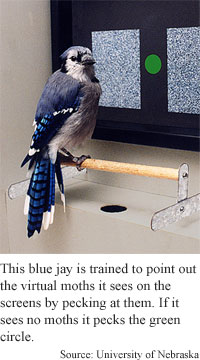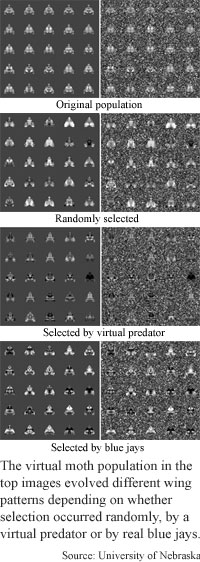
Real
birds change virtual evolution
By
Kimberly Patch,
Technology Research NewsBecause the web of life is such a complicated tangle, it is often difficult to isolate the individual ways animals affect each other. A pair of researchers from the University of Nebraska are making use of modern computer technology to confirm an evolutionary premise about moths and birds that was postulated more than a century ago.
The researchers have shown that the way wing patterns evolve in cryptic moth species, which hide from their predators by blending into the background, is related to the way the minds of blue jays work.
Unlike many other birds that feed on insects by catching them on-the-fly, blue jays are good at finding moths that are still, even when they are on backgrounds similar to the moths' coloration. "Blue jays naturally prey on these cryptic moths in the real world -- they can find [them] sitting on tree trunks," said Alan Bond, a research professor of biological sciences at the University of Nebraska at Lincoln.
The wing patterns of cryptic moths often vary within a species, and a population can have several distinct pattern variants. Researchers have long thought that this phenotypic diversity is promoted by predators attacking the more common patterns disproportionately often.
To test the hypothesis the researchers used a population of 200 virtual moths, showing 50 each to four real blue jays every day. The virtual moths were projected onto a similarly colored mottled gray and white background.
The blue jays were trained to point out the moths they spotted. Each bird was shown 50 moths and 50 backgrounds with no moth. "And what he has to do is decide whether there's a moth there or not and if there is he pecks the moth. If there isn't, he pecks a little green circle that [means] nope, not here, go on to the next one," said Bond. It takes each blue jay a little under an hour to complete the 100 trials, he said.
Every night the genetic algorithm spawned a new generation of virtual moths by crossing those that the blue jays did not see, giving the jays 200 new moths to look for every day.
After 100 generations, the moths had become more difficult to see, and their coloration was more varied, said Bond. The results of the blue jays selectively paring the population were "much better than would be expected on the basis of genetic drift," he said.
The average increase in crypticity was 29 percent, according to Bond. "You get a large portion of the population that's really very difficult to see."
Because the population's coloration also got more varied, it is likely that the blue jays find the cryptic moths by looking for certain features, said Bond. It looks like the features the birds pick have a low enough probability of occurring in the background that it is rewarding to search for the features, he said.
This strategy makes it less likely that a blue jay will find a moth that does not have a common mark -- like a pair of white dots, or a black 'M' shape on a certain part of the wing -- that the bird is looking for. And if the birds are tending to eat moths that have a common mark, the group of moths that live to produce the next generation will tend to be more variable.
The researchers compared their blue jay results to two other sets of results run through the same genetic algorithm: non-selected, and frequency-independent. The non-selected set randomly selected which moths propagated. The frequency-independent set found and removed moths with the same accuracy as the real birds, but did not take into account that the birds may be zeroing in on specific markings. "It's a simulation of the jay in a very simple-minded fashion. And what happens is [the moths], get cryptic, but they don't have the same level of variability that they do with real jays," said Bond.
The results essentially show how the birds' brains affect their environments, said Bond. "This is a clean demonstration of... the imposition of the way the bird thinks about its world on the form of the world," he said. "The birds' cognitive system... changes the way the moths appear as a consequence of nothing more than the way the blue jay tends to process information. There's a level of interdependence between species that you don't normally think about."
The researchers are currently experimenting with different backgrounds, said Bond.
The preliminary results show that a background with a black and white cow-type pattern causes a moth population to swing from mostly black to mostly white and back again. This is probably because once the birds home in on finding one type of moth -- such as black moths on white backgrounds -- they concentrate on picking off the moths on white backgrounds, which eventually causes a moth population to shift to mostly white, said Bond. When this happens, the birds switch to finding white moths on black backgrounds, which in turn causes the moth population to shift back to black, he said.
The method should allow researchers to investigate many evolutionary phenomena in a way that has not previously been possible, said Bond. "We've got plans in the works to look at... changes in the appearance of prey items depending on whether they're distasteful or tasty. There are a whole bunch of predictions as to how this should come out [but] there's been no easy way to do this in the past," he said.
This type of investigation into the mechanics of a bird's mind may eventually help computer scientists working with neural networks, said Bond. "It seems like some features of this work having to do with how the bird searches could find some application in finding... more efficient ways of searching through visual images," he said.
Bond's research colleague is Alan C. Kamil. They published the research in the February 7, 2002 issue of the journal Nature. The research was funded by the National Science Foundation (NSF).
Timeline: Now
Funding: Government
TRN Categories: Applied Computing; Artificial Life and Evolutionary Computing
Story Type: News
Related Elements: Technical paper, "Visual Predators Select for Crypticity and Polymorphism in Virtual Prey," Nature, February 7, 2002.
Advertisements:
February 20, 2002
Page One
DNA map IDs diseases
Real birds change virtual evolution
Material turns infrared to green
Nanotube chips draw near
Chip provides more bang


News:
Research News Roundup
Research Watch blog
Features:
View from the High Ground Q&A
How It Works
RSS Feeds:
News
Ad links:
Buy an ad link
| Advertisements:
|
 |
Ad links: Clear History
Buy an ad link
|
TRN
Newswire and Headline Feeds for Web sites
|
© Copyright Technology Research News, LLC 2000-2006. All rights reserved.